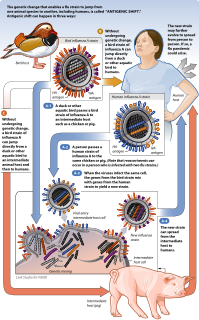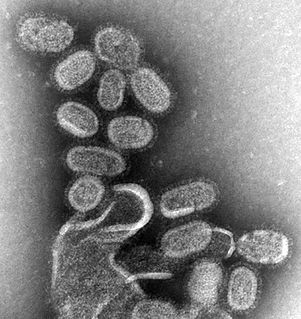
Influenza A virus (IAV) causes influenza in birds and some mammals, and is the only species of the genus Alphainfluenzavirus of the virus family Orthomyxoviridae. Strains of all subtypes of influenza A virus have been isolated from wild birds, although disease is uncommon. Some isolates of influenza A virus cause severe disease both in domestic poultry and, rarely, in humans. Occasionally, viruses are transmitted from wild aquatic birds to domestic poultry, and this may cause an outbreak or give rise to human influenza pandemics.

Antigenic shift is the process by which two or more different strains of a virus, or strains of two or more different viruses, combine to form a new subtype having a mixture of the surface antigens of the two or more original strains. The term is often applied specifically to influenza, as that is the best-known example, but the process is also known to occur with other viruses, such as visna virus in sheep. Antigenic shift is a specific case of reassortment or viral shift that confers a phenotypic change.

Orthomyxoviridae is a family of negative-sense RNA viruses. It includes seven genera: Alphainfluenzavirus, Betainfluenzavirus, Gammainfluenzavirus, Deltainfluenzavirus, Isavirus, Thogotovirus, and Quaranjavirus. The first four genera contain viruses that cause influenza in birds and mammals, including humans. Isaviruses infect salmon; the thogotoviruses are arboviruses, infecting vertebrates and invertebrates. The Quaranjaviruses are also arboviruses, infecting vertebrates (birds) and invertebrates (arthropods).

Influenza A virus subtype H5N1 (A/H5N1) is a subtype of the influenza A virus which can cause illness in humans and many other animal species. A bird-adapted strain of H5N1, called HPAI A(H5N1) for highly pathogenic avian influenza virus of type A of subtype H5N1, is the highly pathogenic causative agent of H5N1 flu, commonly known as avian influenza. It is enzootic in many bird populations, especially in Southeast Asia. One strain of HPAI A(H5N1) is spreading globally after first appearing in Asia. It is epizootic and panzootic, killing tens of millions of birds and spurring the culling of hundreds of millions of others to stem its spread. Many references to "bird flu" and H5N1 in the popular media refer to this strain.

An agricultural show is a public event exhibiting the equipment, animals, sports and recreation associated with agriculture and animal husbandry. The largest comprise a livestock show, a trade fair, competitions, and entertainment. The work and practices of farmers, animal fanciers, cowboys, and zoologists may be displayed. The terms agricultural show and livestock show are synonymous with the North American terms county fair and state fair.

Swine influenza is an infection caused by any of several types of swine influenza viruses. Swine influenza virus (SIV) or swine-origin influenza virus (S-OIV) is any strain of the influenza family of viruses that is endemic in pigs. As of 2009, the known SIV strains include influenza C and the subtypes of influenza A known as H1N1, H1N2, H2N1, H3N1, H3N2, and H2N3.

In virology, influenza A virus subtype H1N1 (A/H1N1) is a subtype of Influenza A virus. Well known outbreaks of H1N1 strains in humans include the Spanish flu, the 1977 Russian flu pandemic and the 2009 swine flu pandemic. It is an orthomyxovirus that contains the glycoproteins hemagglutinin and neuraminidase. For this reason, they are described as H1N1, H1N2 etc., depending on the type of H or N antigens they express with metabolic synergy. Hemagglutinin causes red blood cells to clump together and binds the virus to the infected cell. Neuraminidase is a type of glycoside hydrolase enzyme which helps to move the virus particles through the infected cell and assist in budding from the host cells.

An influenza pandemic is an epidemic of an influenza virus that spreads across a large region and infects a large proportion of the population. There have been six major influenza epidemics in the last 140 years, with the 1918 flu pandemic being the most severe; this is estimated to have been responsible for the deaths of 50–100 million people. The most recent, the 2009 swine flu pandemic, resulted in under 300,000 deaths and is considered relatively mild. These pandemics occur irregularly.

Influenza A virus subtype H3N2 (A/H3N2) is a subtype of viruses that causes influenza (flu). H3N2 viruses can infect birds and mammals. In birds, humans, and pigs, the virus has mutated into many strains. In years in which H3N2 is the predominant strain, there are more hospitalizations.
Flu is an infectious disease of birds and mammals caused by RNA viruses of the family Orthomyxoviridae, the influenza viruses.

H5N1 genetic structure is the molecular structure of the H5N1 virus's RNA.

Influenza, commonly known as "the flu", is an infectious disease caused by influenza viruses. Symptoms range from mild to severe and often include fever, runny nose, sore throat, muscle pain, headache, coughing, and fatigue. These symptoms begin from one to four days after exposure to the virus and last for about 2–8 days. Diarrhea and vomiting can occur, particularly in children. Influenza may progress to pneumonia, which can be caused by the virus or by a subsequent bacterial infection. Other complications of infection include acute respiratory distress syndrome, meningitis, encephalitis, and worsening of pre-existing health problems such as asthma and cardiovascular disease.

H2N3 is a subtype of the influenza A virus. Its name derives from the forms of the two kinds of proteins on the surface of its coat, hemagglutinin (H) and neuraminidase (N). H2N3 viruses can infect birds and mammals.

The 2009 swine flu pandemic, caused by the H1N1 influenza virus and declared by the World Health Organization (WHO) from June 2009 to August 2010, is the third recent flu pandemic involving the H1N1 virus. The first two cases were discovered independently in the United States in April 2009. The virus appeared to be a new strain of H1N1 that resulted from a previous triple reassortment of bird, swine, and human flu viruses which further combined with a Eurasian pig flu virus, leading to the term "swine flu".
The 2009 flu pandemic in the United States was caused by a novel strain of the Influenza A/H1N1 virus, commonly referred to as "swine flu", that was first detected on 15 April 2009. While the 2009 H1N1 virus strain was commonly referred to as "swine flu", there is no evidence that it is endemic to pigs or of transmission from pigs to people; instead, the virus spreads from person to person. On April 25, the World Health Organization declared a public health emergency, followed concurringly by the Obama administration on April 26.

The 2009 swine flu pandemic in Canada was part of an epidemic in 2009 of a new strain of influenza A virus subtype H1N1 causing what has been commonly called swine flu. In Canada, roughly 10% of the populace has been infected with the virus, with 428 confirmed deaths ; non-fatal individual cases are for the most part no longer being recorded. About 40% of Canadians have been immunized against H1N1 since a national vaccination campaign began in October 2009, with Canada among the countries in the world leading in the percentage of the population that has been vaccinated. The widespread effect of H1N1 in Canada raised concerns during the months leading to the XXI Olympic Winter Games, which took place in Vancouver in February 2010.

This article covers the chronology of the 2009 novel influenza A (H1N1) pandemic. Flag icons denote the first announcements of confirmed cases by the respective nation-states, their first deaths, and relevant sessions and announcements of the World Health Organization (WHO), the European Union , and the U.S. Centers for Disease Control (CDC).
In March and April 2009, an outbreak of a new strain of influenza commonly referred to as "swine flu" infected many people in Mexico and other parts of the world, causing illness ranging from mild to severe. Initial reports suggested that the outbreak had started in February due to farming practices at a pig farm half-owned by Smithfield Foods. Smithfield Foods stated that it had found no clinical signs or symptoms of the presence of swine influenza in the company's swine herd, or among its employees at its joint ventures in Mexico, that it routinely administers influenza virus vaccination to their swine herds and that it conducts monthly testing for the presence of swine influenza. The new strain was identified as a combination of several different strains of Influenzavirus A, subtype H1N1, including separate strains of this subtype circulating in humans and in pigs. The World Health Organization (WHO) and the U.S. Centers for Disease Control and Prevention (CDC) have expressed serious concerns that the new strain, which transmits between humans and has had a relatively high mortality rate in the possible and confirmed Mexican cases, has the potential to become an influenza pandemic. It is reported that, because the virus is already widespread, containment will be impossible.

The pandemic H1N1/09 virus is a swine origin influenza A virus subtype H1N1 strain that was responsible for the 2009 swine flu pandemic. This strain is often called swine flu by the public media. For other names, see the Nomenclature section below.

2009 flu pandemic in India was the outbreak of swine flu in various parts of India. Soon after the outbreak of H1N1 virus in the United States and Mexico in March, the Government of India started screening people coming from the affected countries at airports for swine flu symptoms. The first case of the flu in India was found on the Hyderabad airport on 13 May, when a man traveling from US to India was found H1N1 positive. Subsequently, more confirmed cases were reported and as the rate of transmission of the flu increased in the beginning of August, with the first death due to swine flu in India in Pune, panic began to spread. As of 24 May 2010, 10193 cases of swine flu have been confirmed with 1035 deaths.












